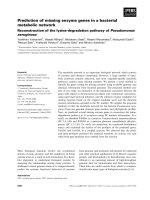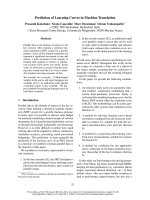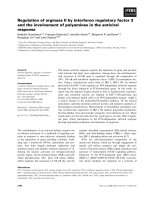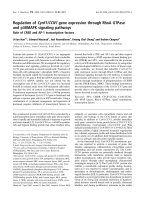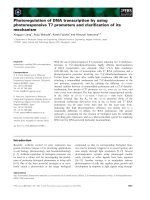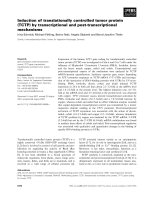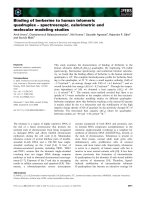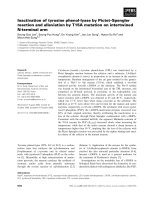Báo cáo khoa học: "Prediction of acorn crops in three species of North American oaks: Quercus alba, Q rubra and Q velutina" docx
Bạn đang xem bản rút gọn của tài liệu. Xem và tải ngay bản đầy đủ của tài liệu tại đây (453.85 KB, 9 trang )
Original
article
Prediction
of
acorn
crops
in
three
species
of
North
American
oaks:
Quercus
alba,
Q
rubra
and
Q
velutina
VL
Sork
JE
Bramble
Department
of
Biology,
University
of
Missouri-St
Louis,
St
Louis,
MO
63121,
USA
Summary —
Many
oak
species
show
tremendous
year-to-year
variation
in
acorn
production.
Is
this
variation
completely
random
or
is
there
some
predictable
pattern?
Using
an
8-year
data
set
of
indi-
vidual
trees
from
3
species
of
oaks
in
central-eastern
Missouri,
we
evaluated
the
patterns
of
acorn
production
in
order
to
identify
critical
external
and
internal
factors.
Our
results
showed
that
flower
counts
can
be
used
to
predict
small
acorn
crop
size
but
high
flower
counts
do
not
always
predict
large
acorn
crops.
In
addition,
we
found
that
each
species
differed
in
the
length
of
the
interval
be-
tween
large
acorn
crops
and
that
acorn
crop
size
was
influenced
by
spring
temperature
and
summer
drought.
Thus,
the
combination
of
physiological
constraints,
reflected
by
intermast
interval,
and
key
weather
factors
can
be
used
to
predict
future
acorn
crop
size.
Quercus
alba
/
Q
rubra
/
Q
velutina
/
mast-fruiting
/
acorn
production
Résumé —
Prédiction
de
la
fructification
chez
3
chênes
américains :
Quercus
alba,
Q
rubra,
Q
velutina.
De
nombreux
chênes
manifestent
de
très
grandes
irrégularités
annuelles
de
fructifica-
tion.
Quelle
est
la
nature
de
ces
variations : est-elle
purement
aléatoire,
ou
peut-elle
être
prédite ?
La
glandée
a
été
observée
au
niveau
d’arbres
individuels
appartenant
à
3
espèces
différentes
pen-
dant
8
années
successives
au
centre-est
de
l’État
du
Missouri
de
manière à
identifier
les
facteurs
critiques
internes
et
externes
intervenant
dans
la
glandée.
Quand
la
floraison
est
faible,
la
glandée
peut
être
prédite
à
partir
du
comptage
des
fleurs;
par
contre,
les
floraisons
importantes
ne
sont
pas
corrélées
à
des
fructifications
élevées.
Des
différences
spécifiques
ont
été
observées
dans
le
délai
(nombre
d’années)
séparant
2
glandées
importantes.
Le
niveau
de
fructification
dépend
des
tempér-
atures
printanières
et
de
la
sécheresse
estivale.
En
conclusion,
les
contraintes
physiologiques,
révé-
lées
par
les
délais
entre
fructifications
élevées,
et
les
facteurs
climatiques
peuvent
être
utilisés
pour
prédire
le
niveau
des
fructifications.
Quercus
alba
/ Q
rubra
/
Q
velutina
/ fructification
massive / production
de
graines
*
Present
address:
Department
of
Biology,
St
Louis
University,
St
Louis,
MO
63103,
USA
INTRODUCTION
It
has
commonly
been
observed
that
many
oak
species
do
not
produce
good
acorn
crops
every
year
(eg
Carmen
et
al,
1987;
Christisen
and
Kearby,
1984).
While
some
species
of
oaks,
usually
the
smaller-
seeded
ones
(Sork,
in
press),
produce
at
least
some
acorns
almost
every
year,
oth-
er
species
produce
acorn
crops
much
more
intermittently.
In
order
to
assess
fu-
ture
acorn
availability
for
wildlife
or
for
seed
collections
for
tree
seedling
nurser-
ies,
it
would
be
advantageous
to
be
able
to
predict
when
good
acorn
crops
will
occur.
This
communication
presents
our
recom-
mendations
on
how
to
predict
acorn
crops
in
3
Missouri
oad
species,
white
oak
(Quercus
alba
L),
northern
red
oak
(Q
ru-
bra)
and
black
oak
(Q
velutina).
We
sum-
marize
herein
the
results
of
a
prior
study
that
examined
internal
and
external
factors
which
influence
the
size
of
acorn
crops
in
these 3
species
(Sork
et
al,
in
press)
and
we
present
additional
results
to
illustrate
the
biology
of
flowering
and
fruiting
in
oaks.
Ecologists
often
call
the
phenomenon
of
producing
good
crops
some
years
and
poor
crops
in
other
years,
mast-seeding
or
mast-fruiting
(Janzen,
1971;
Silver-
town,
1980).
A
year
of
good
acorn
pro-
duction
is
called
a
mast-year.
Because
the
size
of
a
flower
crop
constrains
the
size
of
the
acorn
crop,
it
is
critical
to
eval-
uate
the
extent
to
which
flower
availability
determines
acorn
crop
size.
A
second
po-
tentially
important
factor
in
acorn
produc-
tion
is
the
role of
weather
conditions.
Sev-
eral
studies
have
suggested
or
demonstrated
that
weather
has
strong
im-
pact
(Goodrum
et al,
1971;
Minima,
1954;
Romashov,
1957;
Sharp
and
Chisman,
1961;
Sharp
and
Sprague,
1967).
A
third
factor
is
the
impact
of
prior
acorn
produc-
tion
on
the
resource
availability
for
current
acorn
crop
size.
It
is
possible
that
produc-
tion
of
a
large
acorn
crop
depletes
the
re-
sources
of
a
tree
so
that
it
is
unable
to
produce
another
crop
for
several
years
(Koslowski,
1971).
For
tree
species
which
show
a
mast-fruiting
pattern,
a
specific
length
of
time
between
mast
crops
may
be
inherent.
MATERIALS
AND
METHODS
The
study
site
(38°
31’
N,
90°
33’
W)
was
Tyson
Research
Center,
an
ecological
preserve
admin-
istered
by
Washington
University,
located
near
Eureka,
St
Louis
Co,
Missouri.
This
area
is
situ-
ated
on
the
unglaciated
northeastern
end
of
the
Ozark
plateau
and
is
described
in
detail
in
Sork
et
al
(in
press).
The
study
species
belong
to
2
different
subgenera
of
oaks.
White
oak
(Quer-
cus
alba
L)
belongs
to
the
subgenus
Quereus
while
black
and
northern
red
oak
(Q
velutina
Lam,
and
Q
rubra
L)
belong
to
the
subgenus
Erythrobalanus.
The
floral
biology
of
these
spe-
cies
is
described
elsewhere
(Minima,
1954;
Romashov,
1957;
Sork
et al,
in
press).
Since
1981,
we
have
been
monitoring
flower
and
acorn
production
in
12-15
individual
trees
of
each
species
(DBH
range
=
28,5-57,5
cm,
Sork
et
al,
in
press).
To
estimates
total
crop
size,
we
placed
8
0.5-m
cone-shaped
acorn-collecting
traps
(see
Christisen
and
Kearby,1984)
beneath
the
canopy
of
each
tree
so
that
they
were
scat-
tered
throughout
the
canopy
but
not
beneath
the
canopy
of
neighboring
conspecifics.
The
total
trap
area
sampled
was
on
average
ca
7.5%
of
the
canopy
(range:
4-19%).
Collections
were
made
on
a
weekly
basis.
We
opened
all
the
acorns
to
determine
whether
they
were
imma-
ture
or
mature
and
infested,
maldeveloped
(un-
sound)
or
apparently
viable.
Our
estimates
of
to-
tal
crop
size
are
based
on
the
number
of
mature
acorns
produced
by
the
entire
canopy
of
a
tree
as
a
function
of
the
percentage
of
the
canopy
sampled
by
our
collection
traps.
In
early
May
and
late
August
of
each
year,
we
counted
the
density
of
flowers
on
the
outer
75
cm
of
5
upper
canopy
branches/tree
by
means
of
a
truck
with
a
hydraulically-raised
bucket.
During
the
late
August
sample,
we
also
measured
the
length
of
vegetative
growth
branch
for
that
year.
To
address
the
question
of
how
weather
af-
fects
acorn
crop
size,
we
used
minimum
temper-
ature,
maximum
temperature
and
precipitation
which
were
recorded
daily
at
Tyson
Research
Center.
We
used
these
data
to
calculate
weath-
er
variables
corresponding
to
different
seasons
to
identify
the
critical
weather
factors
(See
Sork
et
al,
in
press,
for
more
complex
statistical
anal-
ysis
using
principal
components
and
stepwise
regressions.)
To
evaluate
the
impact
of
prior
acorn
produc-
tion
on
crop
size
for
the
3
species,
we
per-
formed
an
autocorrelation
analysis
of
mature
acorn
crop
size
with
acorn
crop
size
1,
2, 3,
4
years
earlier,
separately
for
each
individual
study
tree
of
each
species.
For
example,
to
eval-
uate
the
1
year
lag
autocorrelation,
we
correlat-
ed
a
tree’s
acorn
crop
size
for
a
given
year
with
the
acorn
crop
size
1
year
earlier
for
8
years
of
the
study.
Thus,
the
autocorrelation
for
1
year
is
based
on
7
observations,
for
2
years
it
is
based
on
6
observations,
etc.
Then,
for
the
entire
pop-
ulation
we
calculated
the
average
correlation
co-
efficient
and
used
a
t-test
to
see
whether
it
was
significantly
different
from
zero.
As
additional
evidence
for
the
hypothesis
that
acorn
crop
size
is
related
to
resource
availabili-
ty,
we
evaluated
whether
the
acorn
density
on
upper
canopy
branches
correlated
with
the
veg-
etative
growth
on
those
same
branches.
If
re-
sources
are
limiting
and
the
tree
must
partition
its
energy
into
sexual
versus
vegetative
repro-
duction,
one
might
expect
an
inverse
relation-
ship
between
these
2
variables.
RESULTS
AND
DISCUSSION
Our
observations
from
1981
to
1988
showed
that
acorn
crop
sizes
differed
dra-
matically
across
years
and
among
the
3
species
(fig 1).
Black
oak
was
the
most
consistent
acorn
producer:
in
almost
every
year
except
1983
and
1984,
each
study
tree
produced
a
moderate
(>
500
to
>
1000)
number
of
mature
acorns.
During
that
same
interval,
northern
red
oak had
one
large
crop
and
two
moderate
crops,
while
white
oak had
two
large
crops
and
one
moderate
crop.
Statistical
tests
re-
vealed
that
acorn
production
was
synchro-
nous
within
a
species
(Sork
et
al,
in
press).
Thus,
a
good
year
for
one
tree
was
generally
a
good
year
for
all
trees
of
that
species
at
that
study
site.
The
3
species
shared
the
same
bad
years
but
they
did
not
produce
their
mast
crops
during
the
same
years
(fig
1).
How
important
is
the
flower
crop?
The
data
we
obtained
by
monitoring
flower
initiation
and
survival
in
the
upper
canopy
demonstrate
that
the
initial
size
of
the
flow-
er
crop
is
a
major
determinant
of
acorn
crop
size
(see
table
I).
For
each
species,
the
correlation
between
flowers
and
ma-
ture
acorns
branch
was
relatively
high
(black
oak:
r
=
0.964,
n
=
5,
P
<
0.05;
northern
red
oak:
r
=
0.914,
n
=
5,
P
<
0.05;
white
oak:
r =
0.574,
n
= 7,
P
< 0.20).
However,
it
is
also
clear
that
sometimes
flower
availability
is
high
but the
acorn
crop
size
is
low
(eg,
black
oak and
northern
red
oak
in
1984
and
white
oak
in
1981).
Thus,
survival
of
those
flowers
through
acorn
maturation
is
a
critical
variable.
In
fact,
for
northern
red
oak
and
white
oak,
branch
acorn
density
was
significantly
correlated
with
flower
survival
(red
oak:
r =
0.905,
n
=
5,
P
<
0.05;
white
oak:
r
= 0.869,
n
=
7,
P
<
0.05).
In
sum,
low
flower
counts
in
spring
can
reliably
predict
small
acorn
crop
sizes
but
high
flower
counts
do
not
necessarily
indicate
a
large
acorn
crop.
Impact
of
weather
on
acorn
production
In
a
separate
paper,
the
principal-
component
and
single-variable
analyses
revealed
that
spring
weather
variables
were
important
for
all
3
species
(Sork
et
al,
in
press).
Moreover,
the
single
weather
variable
that
consistently
showed
the
high-
est
correlation
coefficients
for
each
oak
species
was
spring
temperature
during
the
year
of
acorn
maturation
(fig
2).
The
higher
the
average
maximum
temperature
during
the
last
2
weeks
of
April
and
the
1
week
of
May,
the
greater
the
number
of
mature
acorns
(see
Sork
et
al,
in
press).
For
all
3
species,
this
is
the
period
when
ovules
are
maturing
and
the
pollen
is
growing
(Mini-
ma,
1954;
Romashov,
1957).
In
white
oak,
it
is
also
the
time
when
pollination
occurs.
The
other
weather
variable
that
showed
relatively
high
correlation
coefficients
across
the
3
species
is
summer
drought.
This
variable
combines
temperature
and
rainfall
(Sork
et
al,
in
press)
and
was
con-
sistently
negatively
correlated
with
acorn
production
(black
oak:
r =
-0.665,
n
=
8,
P
<
0.10;
northern
red
oak:
r
=
-0.705,
n
=
8,
P
<
0.10;
white
oak:
r
=
-0.627,
n = 8,
P
<
0.10).
The
2
worst
years
for
acorn
pro-
duction
(1983
and
1984)
were
associated
with
high
levels
of
drought.
It
is
possible
that
drought
may
not
be
linearly
associated
with
crop
size,
but
may
act
at
some
critical
level
of
stress
to
influence
early
fruit
ab-
scission.
More
years
of
data
are
necessary
to
further
evaluate
this
hypothesis.
Late
spring
frost
has
been
hypothesized
as
a
possible
limitation
on
acorn
crop
size
due
to
frost
damage
to
flowers
(Minima,
1954).
Northern
red
oak
was
the
only
spe-
cies
which
had
a
significant
negative
corre-
lation
between
late
spring
frost
during
the
year
of
flower
anthesis
and
acorn
crop
size
(r
= -0.803,
n
=
8,
P
<
0.05).
Of
the
3
spe-
cies,
northern
red
oak
is
usually
the
first
species
to
break
bud and
therefore
may
be
more
vulnerable
to
a
late
spring
frost.
Thus
even
though
these
3
species
of
North
American
oaks
had
different
patterns
of
acorn
production
across
the
8
year
sam-
pling
period,
they
showed
similar
patterns
of
correlation
with
weather
variables.
High
spring
temperature
and
low
summer
drought
may
both
be
useful
in
predicting
large
acorn
crops
for
these
species.
For
northern
red
oak
in
Missouri,
late
spring
frost
can
have
an
additional
negative
im-
pact
on
acorn
crop
size.
Impact
of
prior
acorn
production
Our
final
analysis
examined
the
impact
of
prior
acorn
production
on
acorn
crop
size
in
order
to
evaluate
whether
there
are
physiological
limitations
preventing
each
species
from
producing
good
acorn
crops
every
year.
The
pattern
of
annual
variation
in
mean
crop
size
demonstrates
that
each
species
differs
in
its
degree
of
fluctuation
(fig
1).
The
autocorelation
of
individual
with
prior
acorn
production
showed
that
all
3
species
displayed
significant
neg-
ative
correlations
with
prior
acorn
produc-
tion
(table
II).
This
suggests
that
prior
acorn
production
does
influence
crop
size.
However,
the
species
differed
in
their
re-
spective
patterns.
For
example,
northern
red
oak
showed
a
negative
correlation
for
crops
produced
2
and
3
years
earlier,
while
white
oak
showed
a
negative
correla-
tion
for
crops
produced
2
and
4
years
earli-
er
(table
II).
We
interpret
the
negative
cor-
relations
as
reflecting
physiological
constraints
on
the
length
of
time
each
spe-
cies
requires
to
accumulate
sufficient
re-
sources
to
produce
another
large
acorn
crop,
and
hypothesize
that
intervals
of
pos-
itive
correlation
correspond
to
an
internal
cycle
of
mast
years
for
each
species.
If
resource
availability
is
a
limiting
factor
in
acorn
production,
then
we
might
expect
that,
during
a
mast
year,
resources
should
be
allocated
to
sexual
rather
than
vegeta-
tive
reproduction.
In
fact,
it
is
likely
that
developing
acorns
are
a
strong
sink
for
photosynthate.
This
hypothesis
is
support-
ed
by
an
inverse
relationship
between
vegetative
growth
and
mature
acorn
densi-
ty.
The
data
suggest
such
a
relationship
for
black
and
northern
red
oak
(fig
3).
In
white
oak,
for
which
we
have
only
4
years
of
observations,
no
relationship
is
appar-
ent.
While
the
data
are
suggestive,
more
years
will
be
needed
to
statistically
evalu-
ate
whether
these
oak
species
partition
en-
ergy
into
either
reproductive
or
vegetative
growth.
CONCLUSIONS
This
intensive
study
on
one
Missouri
forest
stand
suggests
that
acorn
production
is
in-
fluenced
by
both
weather
conditions
and
a
species-specific
inherent
cycle
of
acorn
production.
Flower
availablility
and
flower
survival
determine
acorn
crop
size.
But
the
physiological
constraints
of
the
tree
deter-
mine
when
a
mast
crop
can
occur
and
weather
influences
the
final
crop
size.
Se-
vere
weather
conditions
may
completely
alter
a
tree’s
physiological
state.
Because
populations
of
trees
produce
large
crops
synchronously,
the
length
of
the
intermast
interval
is
probably
similar
among
trees
within
a
population.
However,
this
inherent
cycle
within
a
species
may
differ
across
re-
gions.
Consequently,
it
is
important
to
un-
derstand
the
reproductive
biology
of
the
lo-
cal
species
in
order
to
make
accurate
predictions
about
patterns
of
acorn
pro-
duction.
ACKNOWLEDGMENTS
We
are
grateful
to
Washington
University
for
permission
to
work
at
Tyson.
This
project
has
been
supported
by
funds
to
VLS
from
the
USDA
Forest
Service
Cooperative
Grant
program,
the
Missouri
Department
of
Conservation,
the
Univerity
of
Missouri-St
Louis,
and
the
National
Science
Foundation
(#RII-8503512,
BSR
8814620).
We
thank
Owen
Sexton
and
Richard
Coles
for
help
with
this
project.
We
also
ac-
knowledge
the
contribution
of
the
numerous
undergraduates
and
graduates
who
provided
field
assistance
(see
Sork
et
al,
in
press).
We
thank
Bette
Loiselle
for
comments
on
this
manu-
script.
REFERENCES
Carmen
WJ,
Koenig
WD,
Mumme
RL
(1987)
Acorn
production
of
five
species
of
oaks
over
a
seven-year
period
at
the
Hastings
Reserva-
tion,
Carmel
Valley,
California.
In:
Poceed-
ings
of
the
Symposium
on
Multiple-use
Man-
agement
of
California’s
Hardwood
Resources
(Plumb
TR,
Pillsbury
NH,
eds)
Pac
South-
west
For
Exp
Range
Stn,
Berkeley,
CA,
429-
434
Christisen
DM,
Kearby
WH
(1984)
Mast
meas-
urement
and
production
in
Missouri
(with
special
reference
to
acorns).
Missouri
Con-
serv
Terrestr
Ser
No
13,
1-34
Goodrum
PD,
Reid
VH,
Boyd
CE
(1971)
Acorn
yield
characteristics,
and
management
crite-
ria
of
oaks
for
wildlife.
J
Wildl
Manage
35,
520-532
Janzen
DH
(1971)
Seed
predation
by
animals.
Annu
Rev
Ecol
Syst 2,
465-492
Kozlowski
TT
(1971)
Growth
and
Development
of
Trees.
vol
II.
Academic
Press,
New
York
Minima
EG
(1954)
Biological
basis
of
flowering
and
fruit
bearing
in
oak.
Tr
Inst
Lesa
Akad
Nauk
SSSR
17,
5-97
(translated
and
pub-
lished
by
Indian
Nat
Sci
Documention
Centre)
Romashov
NV
(1957)
Laws
governing
fruiting
in
oak.
Bot Zh 42, 41-56
Sharp
WM,
Chisman
HH
(1961)
Flowering
and
fruiting
in
the
white
oaks.
I.
Staminate
flowering
through
pollen
dispersal.
Ecology 42, 365-372
Sharp
WM,
Sprague
VG
(1967)
Flowering
and
fruiting
in
the
white
oaks;
pistillate
flowering,
acorn
development,
weather,
and
yields.
Ecology
48,
243-251
Silvertown
JW
(1980)
The
evolutionary
ecology
of
mast
seeding
in
trees.
Biol
J
Linn
Soc
14,
235-250
Sork
VL
(1993)
The
evolutionary
ecology
of
mast-seed
in
temperate
and
tropical
oaks
(Quercus
spp).
In:
Frugivory
and
Seed
Dispersal:
Ecological
and
Evolutionary
As-
pects
(Fleming
T,
Estrada
A,
eds)
Kluwer
Academic
Press,
Dordrecht,
The
Nether-
lands
Sork
VL,
Bramble
J,
Sexton
O
(1993)
The
ecolo-
gy
of
masting
in
three
species
of
North
Amer-
ican
deciduous
oaks.
Ecology
(in
press)

